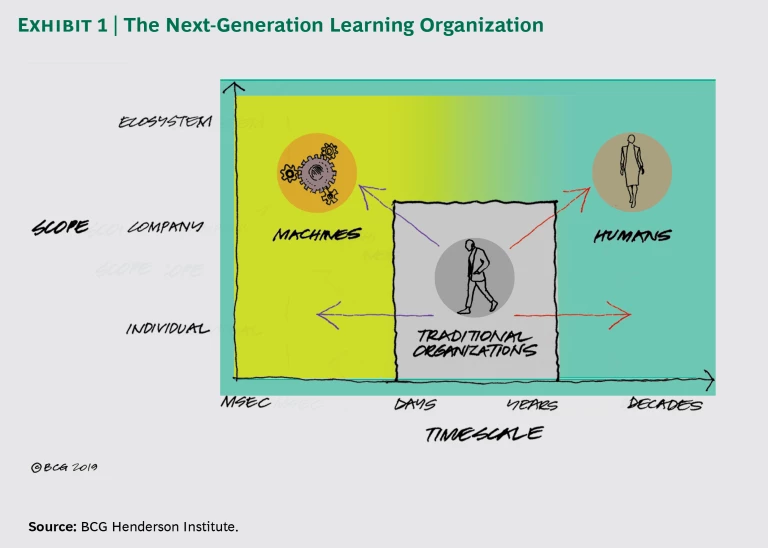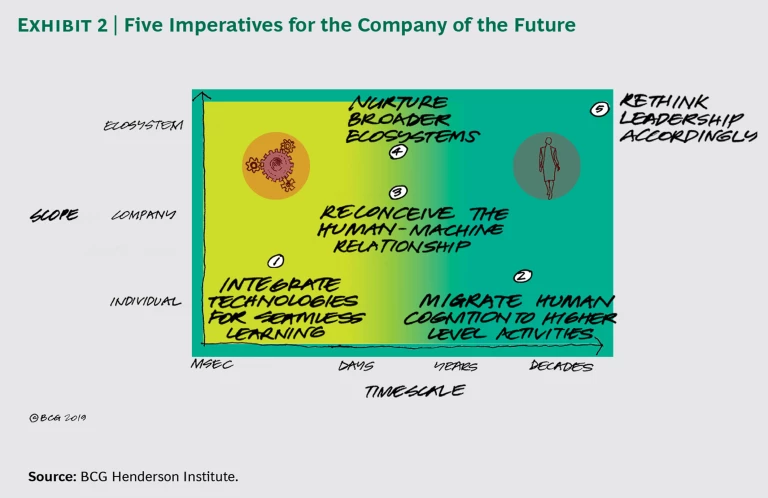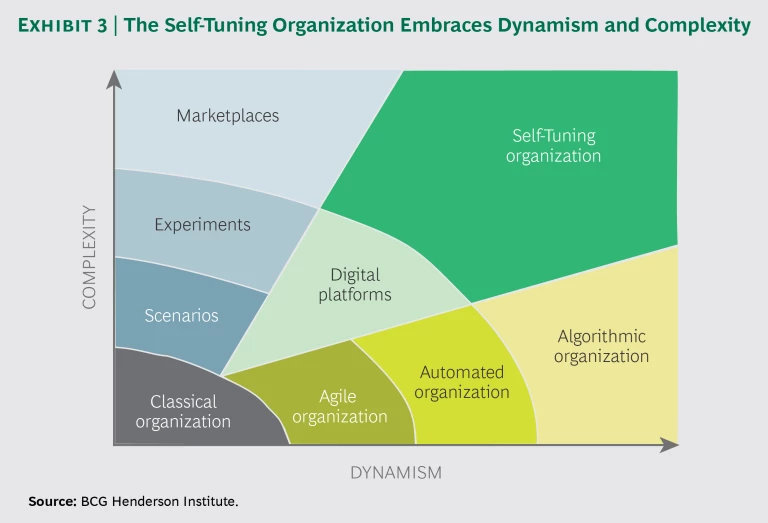I n the coming decade, companies will increasingly need to compete on the rate of learning . Technology promises to play a critical role: artificial intelligence can detect patterns in complex data sets at extreme speed and scale, enabling dynamic learning. This will allow organizations to constantly adapt to changing realities and surface new opportunities, which will be increasingly important in an uncertain and fast-changing environment.
But for companies to compete on learning, it is not enough to merely adopt AI, which alone can accelerate learning only in individual activities. As with previous transformative technologies, unlocking the
full potential of AI
—and of humans—will require fundamental organizational
In other words, to win the ’20s, leaders will need to re-invent the enterprise as a next-generation learning organization.
Reimagine the Organization
The next-generation learning organization will need to be redesigned to fulfill several key functions: (See Exhibit 1.)
- Learning on All Timescales. The growing opportunity and need to learn on faster timescales, driven by technological innovation, is well known—algorithmic trading, dynamic pricing, and real-time customized product recommendations are already a reality in many businesses. But it is perhaps under-appreciated that slow-moving forces are also becoming more important . For example, trade institutions, political structures, wealth stratification, and social attitudes are slowly changing in ways that could have a profound impact on business. Gone are the days when business leaders could focus only on business and treat these broader variables as constants or stable trends. But such shifts unfold over many years or even decades. In order to thrive sustainably, businesses must learn on all timescales simultaneously .
- Combining Humans and Machines Optimally. Machines have been crucial components of businesses for centuries—but in the AI age, they will likely expand rapidly into what has traditionally been considered white-collar work. Instead of merely executing human-directed and designed processes, machines will be able to learn and adapt, and will therefore have a greatly expanded role in future organizations. Humans will still be indispensable, but their duties will be quite different when complemented or substituted by intelligent machines.
- Integrating Economic Activity Beyond Corporate Boundaries. Businesses are increasingly acting in multicompany ecosystems that incorporate a wide variety of players. Indeed, seven of the world’s largest companies, and many of the most profitable ones, are now platform businesses. Ecosystems greatly expand learning potential: they provide access to exponentially more data, they enable rapid experimentation, and they connect with larger networks of suppliers of customers. Harnessing this potential requires redrawing the boundaries of the enterprise and effectively influencing economic activity beyond the orchestrating company.
- Evolving the Organization Continuously. The need for dynamic learning does not apply just to customer-facing functions—it also extends to the inner workings of the enterprise. To take advantage of new information and to compete in dynamic, uncertain environments, the organizational context itself needs to be evolvable in the face of changing external conditions.
Today’s organizations, which were designed for more stable business environments, are not well-suited to perform these functions. Reinventing the organization for the next decade will require embracing five imperatives: (See Exhibit 2.)
- Integrate technologies for seamless learning.
- Migrate human cognition to new, higher-level activities.
- Redesign the relationship between machines and humans.
- Nurture broader ecosystems.
- Rethink management and leadership accordingly.
Integrate Technologies for Seamless Learning
As powerful as today’s emerging technologies are, they will yield only incremental gains if they simply enhance individual steps of existing processes. The effective rate of an organization’s learning is gated by its ability to act on new insights. And classical organizations act slowly, owing to their reliance on human decision making and hierarchy.
In order to truly accelerate the speed of learning to algorithmic timescales, organizations will need not only to automate but also to “autonomize” significant parts of their businesses. In traditional automation, machines execute a pre-designed process repeatedly and consistently. In autonomization, machines use continuous feedback to act, learn, and adapt on their own—without the bottleneck of human intervention.
Organizations will need not only to automate but also to “autonomize” significant parts of their businesses.
Autonomous systems are designed by combining multiple technologies into integrated learning loops. Data from digital platforms automatically flows into AI algorithms, which mine the information in real time to facilitate new insights and decisions. These are wired directly into action systems, which continuously optimize outcomes under changing conditions. These actions produce yet more data that can be fed back through the cycle, closing the loop and allowing the organization to learn at the speed of algorithms.
Some organizations are already implementing autonomous learning systems. For example, Amazon’s pricing and product recommendation engines, among dozens of other functions, are operated by AI systems that learn and adapt as new information emerges. And these systems are interconnected, so new data or insights from one part of the business cascade through all other functions, which react
In contrast, traditional organizational approaches—for example, unchanging rules or hierarchical decision processes—can impede companies’ ability to harness the rapid learning potential unlocked by technology. As BCG’s research on Smart Simplicity has shown , today’s organizations already face the need to reduce bureaucracy and complicatedness in order to promote fluid collaboration. With the introduction of AI and other new technologies, leaders need to redouble their efforts to simplify their organizations to enable autonomous learning as well as more effective human-to-human collaboration.
Actions that companies can take to harness autonomous learning include:
- Gather real-time data on all aspects of the business by leveraging platforms, the Internet of Things, and other new technologies.
- Deploy AI at scale, integrated with data and decision-making systems.
- Take human hierarchy “out of the loop” of routine, data-based decision making.
Migrate Human Cognition to New, Higher-Level Activities
The widespread adoption of autonomous learning machines naturally raises the question of what role human workers will play in the organization of the future. Today, there is already widespread concern about the speed at which technology will disrupt the future of work. To shape this future—and to maximize organizational learning capabilities—businesses need to focus human cognition on its unique strengths.
Businesses need to focus human cognition on its unique strengths.
For all its power and potential, AI is still inherently limited in its cognitive scope. It can analyze correlations in data (“what is the case”) at extreme speed, on extreme scales, with extreme complexity. But it cannot reason at higher levels, such as causal inference (“why is it the case”) or counterfactual thinking (“what is not the case but could be”).
Humans should increasingly focus their efforts on these higher-level activities. For example, while correlative analysis is generally sufficient for learning about repeated actions on fast timescales, it is less useful for learning about slow-moving forces, such as political, social, and economic trends. These shifts are unique and depend on the historical context and trajectory, which means there is no repeated data set in which to find patterns. Human abilities, such as understanding causal relationships and generalizing from limited data, are necessary to decode these forces and adapt the organization accordingly.
Counterfactual thinking is also critical, as businesses need increasingly to compete on imagination. Existing business models are being exhausted faster, and long-term growth is declining, which means companies must continually generate new ideas to grow sustainably. But businesses today, which are often implicitly designed for efficiency and the maximization of short run financial outcomes, are not conducive to imagination . Organizations will need to better facilitate individual and collective imagination.
Apple provides a prescient example. When Steve Jobs returned to Apple as CEO in 1997, he made design the core of the company’s culture, instead of functions like engineering and finance, which had previously been dominant. By focusing on design—which leverages human creativity and imagination to generate new ideas—Apple was able to produce the novel products, including the iPhone, that eventually helped it become the world’s most valuable company.
In addition to imagination and making sense of non-repeated events, there will be many other activities where humans are advantaged, including organizational design, algorithmic governance, ethics, and purpose, to name a few. In these domains of human activity, organizations will need to become more effective at dynamic collaboration to get the most out of their teams. This requires emphasizing self-organization and experimentation by creating an organizational context in which responsive decision making and learning can thrive, rather than by relying on direct instructions.
Finally, organizations will need to recognize that these new activities are cognitively demanding—which is particularly challenging in an age of exploding inboxes, endless meetings, and ubiquitous information. Organizations will have to allow humans to cultivate the art of reflection and avoid cognitive overload.
How can organizations help humans maximize their value?
- Expose employees to unfamiliar or anomalous information, in order to inspire imagination.
- Schedule and protect time for unstructured reflection.
- Promote new ways of working that enable dynamic learning and adaptation.
Reconceive the Relationship Between Humans and Machines
The first two imperatives call for a hybrid learning organization, one that combines the comparative advantages of machines and humans: machines’ ability to rapidly identify complex patterns in big data and humans’ ability to decode complex causal relationships and imagine new possibilities. Together, these will enable the organization to learn on an expanded range of timescales—faster and slower.
But in hybrid organizations, humans and machines will increasingly have to collaborate in new and more effective ways. This includes tasks that require thinking on multiple levels or timescales simultaneously, as well as tasks that demand social interaction, another dimension in which humans are currently far more effective. Organizations will thus need to reimagine the relationship between humans and machines to bring the best out of both and maximize synergies.
Different types of jobs and tasks will require different types of human-AI
- In jobs that are based predominantly on optimization or pattern recognition, especially at high velocity and scale, humans will likely be substituted by machines. For example, many tasks done today by retail loan underwriters can be performed by AI; in these cases, humans will need to shift their focus to new higher-level tasks to add value.
- In jobs that also require social interaction, machines may take over optimization-related aspects, but a “human layer” will still be critical to deliver messages with empathy and compassion. For example, MIT developed a robot to match nurses with patients and allocate scarce resources in maternity wards, based on patient histories, scheduling constraints, and previous
experience.5 5 S. O’Brien, “MIT robot helps deliver babies,” CNN, July 2016. As a result, nurses and doctors can spend more time interacting with patients directly to provide empathy and personalized care. - In jobs that require more creativity than optimization, humans will likely be complemented by intelligent machines that augment the capacity for creativity and imagination. For example, Maurice Conti, an expert in innovation and technology, describes “generative design tools” that automatically create new possibilities based on a set of predefined parameters, which can spark new ideas for human designers.
- Finally, in jobs that require both creativity and social interaction, humans will have many of the same core responsibilities that they do today, but targeted AI applications will help them maximize their skills. For example, Google and a startup led by former Google employees have developed the Nudge Engine, which uses AI to provide personalized suggestions to employees or managers that enhance their
effectiveness.6 6 D. Wakabayashi, “Firm Led by Google Veterans Uses A.I. to ‘Nudge’ Workers Toward Happiness,” New York Times, December 2018.
For these new types of human-machine relationships to succeed, organizations need to develop effective human-machine interfaces that allow for seamless collaboration. Today’s AI models tend to be “black boxes” that are not designed for interpretability and may therefore impede trust. Organizations will need to overcome these hurdles by developing and implementing interfaces that provide transparency into how AI makes recommendations, allowing humans to understand and validate machines’ actions. Similarly, humans and algorithms are rarely matched for bandwidth and complexity. Choosing the right level of abstraction and compression for communication between humans and computers is critical: too much compression will suppress subtlety and prevent the tinkering through which human innovation proceeds, while too little will overwhelm human overseers.
Today’s AI models tend to be “black boxes” that are not designed for interpretability and may therefore impede trust.
For example, Google’s DeepMind AI system that detects eye diseases was designed to operate in two stages—first identifying what features of the image are associated with eye diseases, and then diagnosing diseases on the basis of those features. This structure allows doctors to see what in the image led to each diagnosis, increasing their trust in the
The frontier of human-machine relationships is still uncertain, but a few imperatives are emerging:
- Segment tasks and jobs according to the challenges they entail and deploy the right configuration of humans and machines against each.
- Leverage collaborative human-machine relationships more intensively.
- Develop explainable algorithms that humans can trust and understand.
Nurture Broader Ecosystems
In traditional models of production, companies operated in a linear value chain to deliver a narrow range of products. However, economic activity is increasingly organized within ecosystems—complex, semifluid networks of companies that cross conventional industry boundaries.
Ecosystems combine information and capabilities from a wide variety of players, increasing their collective ability to explore new paths and learn about the market. They also enable the rapid development of new offerings in response to emerging opportunities that could not have been foreseen. These benefits will be essential in future business environments, which will likely be more complex and less predictable than those of the past.
However, realizing those benefits requires a new organizational logic. Ecosystems cannot be successfully managed with deliberate planning and control. Instead, organizations need to be adaptive in order to respond to signals that emerge from the ecosystem—for example, by implementing internal processes that are flexible and responsive. And they need to develop shaping capabilities to indirectly influence the ecosystem in more beneficial directions—for example, by designing platforms that incentivize other stakeholders to act in certain ways.
Realizing the benefits of ecosystems requires a new organizational logic.
Ecosystems are not only a new method of developing and delivering products; they also provide new opportunities for the “back office” of organizations. The “gig economy” is becoming more prominent , allowing companies to leverage external, freelance talent at scale—thereby enhancing flexibility and giving them access to a wider variety of skills. But harnessing labor-sharing platforms similarly requires indirect forms of management instead of traditional command and control techniques.
For example, the Dutch technology company Philips orchestrates ecosystems in many areas of its business. On the product side, its health care division participates in ecosystems at several stages of value creation—including an innovation ecosystem that involves academic labs, robotics companies, and startups; and a sales and servicing ecosystem based on its tele-health app that connects many digital health care partners. The company also created a labor-sharing platform, Philips Talent Pool, which maintains a pool of freelancers familiar with the company and monitors the quality of their work.
By reconceiving the external and internal workings of the organization as a flexible, evolving ecosystem, businesses can handle much greater dynamism and complexity. This requires subjecting all aspects of the organization to market forces, enabling it to learn and adapt in response to new opportunities. And it requires internal systems that adjust automatically to new information, allowing learning and resource reallocation to occur at algorithmic speed. When combined, these capabilities can create a “self-tuning enterprise” that constantly learns and evolves according to its environment. (See Exhibit 3.)
To harness the power of ecosystems throughout and beyond the organization, leaders must:
- Engage external partners to create a shared vision of the future.
- Develop capabilities for collaboration and information sharing at scale—for example, platforms and APIs.
- Redesign internal processes to be more adaptive and data-driven, allowing the organization to become “self-tuning.”
Rethink Management and Leadership
Collectively, the above imperatives point to a very different way of designing and operating organizations—which in turn will significantly change the role of leadership. In particular, managers and leaders will need to focus on several new challenges.
Developing governance principles for AI and autonomous machines. As machines play a greater part in learning and action, the role of leadership in setting guardrails and priorities will take on greater importance. In the last decade, tech companies could sidestep these topics, as the promise and potential of new technologies gave them a license to move fast. But as social scrutiny of technology increases, questions about governance, trust, and ethics are coming to the forefront. And as AI is adopted more widely, all businesses will have to deal with these difficult questions.
Some organizations are already beginning to address them. For example, Microsoft created a new leadership position to help companies learn how to deploy ethical principles, including fairness, accountability, and transparency, when implementing AI
Unlocking continuous human learning capabilities. As humans increasingly focus on higher-level thinking, they will need to learn and practice new skills. This shift will not be “one-shot” learning—the required abilities will continue to evolve unpredictably. Learning will therefore need to be embedded in the workflow, and responsive to changing needs, rather than being batched at the beginning of careers. Organizations will also need to invest in “learning contracts” with employees , mutually committing to continuously develop new skills for new roles.
Leading in ecosystems. As the scope of the organization expands to encompass broader ecosystems, leaders need to adopt a new approach. Traditional “mechanistic” approaches rely on the assumption that organizational actions can be perfectly planned and controlled, which is no longer valid. Instead, leaders need to adopt a “biological” mindset , which recognizes that businesses are embedded in complex systems that evolve unpredictably. This involves managing with an experimental approach that seeks to learn about the environment and adapt, rather than assuming that current knowledge is sufficient. And it involves prioritizing resilience in order to prepare for outcomes that cannot be anticipated.
Orchestrating an adaptive organization. Similarly, running a self-tuning enterprise requires a different perspective on the role of organizational leadership. Instead of exerting control over teams and intervening directly in operations, leaders should reframe their mandate as orchestrating a complex, dynamic system of individuals and machines, and guiding it to productive outcomes. This can be considered an extension of the shift in leadership mindset from “classical music composer/conductor” to “improvisatory jazz group leader,” as was presciently laid out by former BCG CEO John Clarkeson in 1990 .
As a consequence, the day-to-day activities of managers will change. Traditional management, in the form of direct decision-making, will be reduced—because fewer aspects of the organization can actually be “managed.” Instead, managers need to think of themselves as coaches rather than decision makers, and shift their activities to higher levels, such as shaping the conditions and context of the enterprise .
The organizations that will win the 2020s will look much different from today’s: they will use different capabilities; they will operate at different speeds and scales of influence; they will contain different structures and responsibilities; and they will embody different leadership models to enable all of the above.
Actually making the transition from here to there will not be easy, however. In the next installment of our series on
winning the ’20s
, we will expand on how leaders can master the science of complex change to execute the necessary transformation of their organizations.














